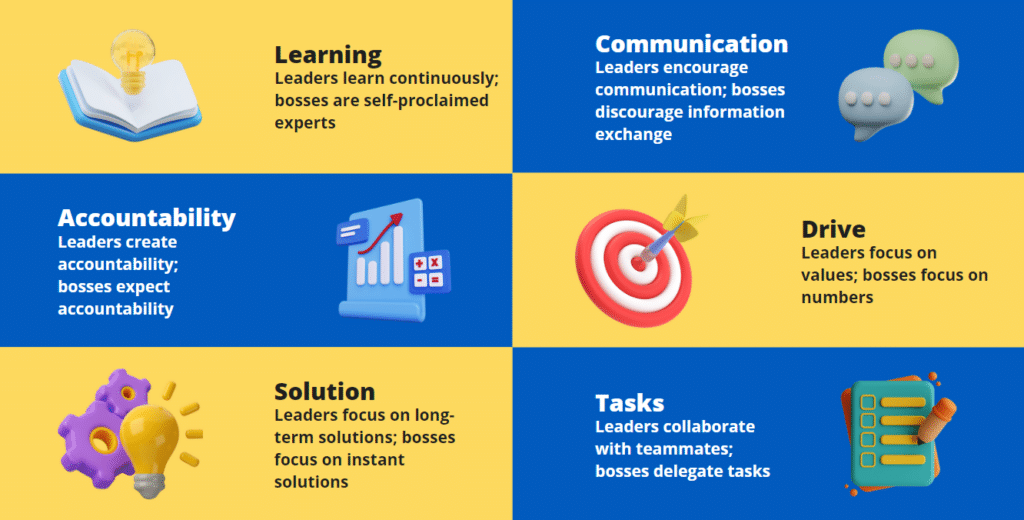Leadership is one of the most crucial aspects of any organization. It is common knowledge that people often change jobs due to poor leadership and executive interests. Influential leaders who can guide the company towards success are a boon for any company as they result in loyal, long-term employees.
Understanding the different leadership styles is essential for HR and management to support the company in finding capable leaders who gel well with their teammates and company culture. While a leader with the right potential can be refined with the help of training, recruiting one with the right mindset and leadership skills will result in enhanced employee management and staff retention.
There are multiple types of leadership styles, such as visionary leader, charismatic leadership, pacesetting leadership style, coaching leader, etc. So, which are the most common leadership styles? Which is the best leadership style? And which is the most effective leadership style? What are leadership styles exactly? And how do leadership styles matter in the grand scheme of things? Let us find out.
What are Leadership Styles?
Leadership Styles refer to the methods adopted by most leaders to manage their employees. Leaders can influence and motivate their employees using a specific style. The style affects how most leaders handle their employees, how they strategize and implement their tactics, and how they improve their team’s morale.
According to Arielle Executive, a branding agency that helps executives land top leadership roles, different types of leadership styles directly affect the organization’s success rate since it affects the employee mindset directly. While great leaders tend to encourage independent thinking and increased automation, a bad one tends to micro-manage their teammates, lowering their morale, enthusiasm, and engagement with the company.
Employees who trust their leaders are likelier to follow them and deliver results. They will also be encouraged to fulfil their duties well if given autonomy over their tasks as they realize their leader trusts them to accomplish their assignments successfully. It also gives them a sense of responsibility towards their functions and ensures accountability.
Employees who have the freedom to accomplish their tasks also provide valuable feedback as they feel free to share their thoughts and have a genuine interest in improving the products, processes, and services of their company. Hence, with the help of the right style, one can enhance their company brand, as well as their employer brand.
Also Read: Compensation Management
Difference between Boss and Leader
In simple terms, a boss is someone who gives out orders and asks their team members to follow them. On the other hand, a leader is someone who leads by example and accomplishes tasks with the help of their teammates. Hence, they create accountability, while bosses expect accountability from their staff.

Leaders are concerned about long-term solutions to pressing problems, while bosses expect quick fixes to immediate concerns. As a result, the leadership role collaborates with their staff to find answers, while the bosses delegate the same to others to get solutions. Hence, it is common to observe leaders actively interacting with their team while bosses restrict communication by trying to route all contact through them.
Bosses and leaders have the clear distinction of being driven by different ideals. While numbers drive bosses, leaders are more concerned with values. As a result, bosses assume they are the best at their work, while leaders constantly try to improve themselves and develop leadership skills.
The differences between leaders and bosses may not be apparent from the interviews. Hence, understanding their leadership style often helps the management and HR team know whether an individual is a leader or boss and trains them to adapt their leadership approach to the company’s work culture.
What is the Relevance of Leadership Styles?
Leadership styles are often influenced by various factors, such as the leader’s personality and experiences. The right leadership style would help the leader understand how to make the right decision in specific circumstances. In the decision-making process, one needs to have a good idea of one’s own leadership style and adapt it as required. A clear vision of one’s style would help smoothly tackle any situation.
The leadership style of the leader or manager also affects the employees working under them. An ideal leader should be able to uplift the morale of their teammates and help them remain engaged with their company. However, if there is a mismatch between the leadership style and the company culture, employees are bound to react negatively to the leader’s initiatives.
For example, if a new manager is micro-managing the team member, they would feel that their company do not have faith in them enough to undertake their tasks effectively. Hence, they would feel demotivated and lose the will to remain productive.
Effective leadership style will also help improve communication within the team as employees would not hesitate to speak their minds and provide valuable feedback. As a result, the management will be able to understand the mindset of their employees and undertake employee welfare activities to have an engaged workforce and improve team bonding.
Common Leadership Styles
There are various common leadership styles commonly adopted by influential leaders. These styles give them a steady persona which helps endear them to their employees.
Hence, let us check out some of the most effective leadership styles:
Coach
A leader with a ‘Coach’ leadership style encourages employees to achieve more by coaching them effectively. While they may not undertake the coaching, they will motivate the staff and encourage them to improve themselves. Coaching leaders can also identify the individual strengths and weaknesses of the teammates and set personalized goals for them.
To help the employees achieve their goals, the ‘coach’ leader also sets clear expectations for their employees and helps them achieve them. They also ensure that the targets are achievable as they know their teammates well.
Being a ‘coach’, leaders with coaching leadership style spend time and effort developing meaningful connections with their teammates. As a result, they create an environment of positivity, understanding and mutual respect.
Servant
A ‘servant’ leader is a servant to their teammates. They will put the needs of their teammates before their own and do everything in their power to ensure their team’s well-being.
They share authority and hence, help others reach their true potential. Although being a servant leader requires high integrity and liberality, it rewards higher morale amongst the team members. The Servant leadership guides their team with a people-first mindset.
Hence, they can effectively make their team members feel valued and engaged with their work, resulting in better productivity. However, it may not be suited for all kinds of work, especially when other competing teams may have different types of leaders.
Visionary
Visionary leaders have an innate ability to innovate and come up with out-of-the-box solutions. Hence, organizations aiming for a transformation or product and service improvements should nurture visionary leaders. These leaders can find innovative solutions to the issues faced by their company and communicate the same to their team, and help develop practical solutions to remediate them.
Visionary leaders also possess the ability to drive progress by inspiring their teammates with new ideas. These leaders create an environment of mutual respect as they are usually creative, open-minded and highly passionate about their work in their field. Hence, companies planning on expanding their portfolio should nurture such leaders and help them encourage their teams to come up with innovative ideas and help implement them successfully.
Autocratic
Autocratic leadership style is commonly associated with decision-makers. Autocratic leaders are seldom concerned with their employees’ feedback or suggestions. They merely want their teammates to carry out their commands without any hassles. Hence, this leadership style is commonly referred to as ‘commanding’, ‘coercive’, and ‘authoritarian leadership’.
Although authoritarian leadership is usually bad for employee morale, they are required in times of crisis where quick decision-makers are necessary. Authoritarian leaders can take responsibility for their decisions and are typically given full authority to dictate over their teammates. Hence, companies generally choose someone with experience and knowledge for the position of an autocratic leader.
Democratic Leadership style
The democratic leadership style is the opposite of autocratic leadership, which encourages employees to participate in decision-making. Democratic leaders check with their team before taking any decisions, and they may even vote to finalize the decision. Democratic leaders provide a voice for their teammates and are usually considered good in the employees’ books.
A leader with a democratic leadership or participative leadership style may delegate some authority to their teammates to undertake their tasks efficiently. Hence, democratic leadership encourages creativity and improved thinking from the teammates, leading to better job satisfaction and increased engagement. Since democratic leadership ensures a happy workforce, it can also improve the service and products of the company.
Transformational Leadership
Transformational leadership style is concerned with transforming teams and organizations. Transformational leaders usually push their teams to perform better. Hence, leaders with transformational leadership are preferred in scenarios such as company expansion, where there is a requirement for leaders who can motivate their teams to work smarter. Additionally, they are usually charismatic, which helps them communicate well and develop deep, meaningful relationships with their teammates.
However, leaders with transformational leadership qualities can also be heavy on the employees as they can potentially ‘burn out’ their employees in pursuing transformation. Hence, adequate precautions should be taken to ensure employees do not feel stifled by transformational leaders.
Transactional
Transactional leadership establishes roles based on transactions to improve employee productivity. If the staff can meet some target or deadline, they are rewarded with incentives; else, they are reprimanded with some form of punishment. While a transactional leadership style will not be helpful in creative ventures, it is ideal for domains where meeting goals is paramount.
Due to the transactional nature of this leadership, transactional leaders often go out of their way to help and groom their staff to ensure that their goals are met within the allocated time. However, care should be taken not to overdo it as it would put the employees working under the transactional leader under extra stress.
Laissez-faire
The ‘Laissez-faire’ leadership style is called the ‘hands-off’ style as it deals with delegating tasks to the team members with complete autocracy over their functions, with little to no supervision. In fact, ‘laissez-faire’ means ‘let them do’ in French. Hence, laissez-faire leadership often have a hands-on approach towards their responsibilities.
We can observe laissez-faire leaders in teams with good experience and well-trained employees who can handle their duties. Such leaders often provide little to no support to their teammates as they believe they can undertake their tasks alone. As a result, it should not be applied to groups where the members are amateurs or rookies.
Emergent
The ’emergent’ leader emerges from the team members over time. Such a leader is seldom elected or appointed by the authorities. As a result, the emergent leader may sometimes face opposition from their teammates since the leader used to be one among them. Hence, they may not recognize an individual as their leader, especially if they try to make some changes as soon as they take charge.
The emergent leader often has a good rapport with their teammates as they require their trust to make them undertake their tasks. Hence, they usually employ reciprocity of favours to ensure a smooth relationship.
Bureaucratic
The ‘bureaucratic’ leadership style will always try to accomplish their team’s tasks by the book. They are often rigid in their ways and offer little to no flexibility to their teammates. These leaders often set the rules for their teams and expect them to follow the regulations methodically. They find new ideas risky and are content with repeating the old ways, which have provided results and set according to the rulebooks.
Due to the inflexible nature of bureaucratic leaders, they are generally found in older companies that believe in following processes by the rules. This leadership style would be highly detrimental to a growing company’s progress.
Conclusion
Various leadership styles, such as pacesetting leaders, visionary leadership, situational leadership, strategic leaders, transformational leader, laissez-faire leader, servant leaders, bureaucratic leadership, and others, can be employed in an organization depending on the size and complexity of the workforce and the work culture. The same leadership style will not work in any organization; depending on the team and their tasks, one may have to apply different leadership styles to manage them effectively. One can also trying switching to other leadership styles if required.
One must employ the utmost discretion in applying a specific leadership style with one’s staff members, as it can make or break the bond between the leader and the team members. Hence, one should always remain friendly and understand the staff’s mindset before deciding on the right approach.








